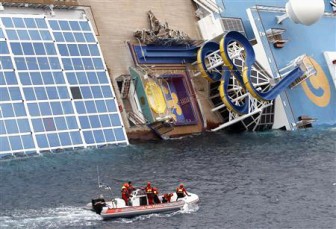GIGLIO, Italy (Reuters) – A stricken Italian cruise liner shifted on its rocky resting place yesterday as worsening weather disrupted an increasingly despairing hunt for survivors and authorities raised their estimate of the number missing to 29 people.

As the Costa Concordia‘s owners blamed their captain for veering shore wards on Friday in a bravura “salute” to residents of a Tuscan island, the giant ship slid a little, threatening to plunge its whole gigantic carcass and 2,300 tonnes of fuel below the Mediterranean waters of the surrounding nature reserve.
The slippage forced rescuers to suspend for a few hours their efforts to find anyone still alive after three days in the capsized hull, resting on a jagged slope outside the picturesque harbour on the island of Giglio. Six bodies have been found. Most of the 4,200 passengers and crew survived, despite hours of chaos.
An Italian coastguard official told Reuters late yesterday that the number of people missing had been revised up to 29 – 25 passengers and four members of staff – from 16, showing how much uncertainty still surrounded the disaster.
Another maritime official said later that 10 Germans were thought to be among the missing passengers.
The 114,500-tonne ship, one of the biggest passenger vessels ever to be wrecked, foundered after striking a rock just as dinner was being served on Friday night. It quickly rolled on its side, revealing a long gouge below the waterline.
Firefighters’ spokesman Luca Cari said there were still small movements of the vessel but they were not considered dangerous. However, searches were suspended overnight and would resume at daybreak.
Another senior firefighter, Luciano Roncalli, told Reuters that all the unsubmerged areas of the liner had been searched, indicating faint hopes of finding more survivors in the flooded and upturned maze of luxurious state rooms and tennis courts, bars and spas that are now submerged beneath the sea.


